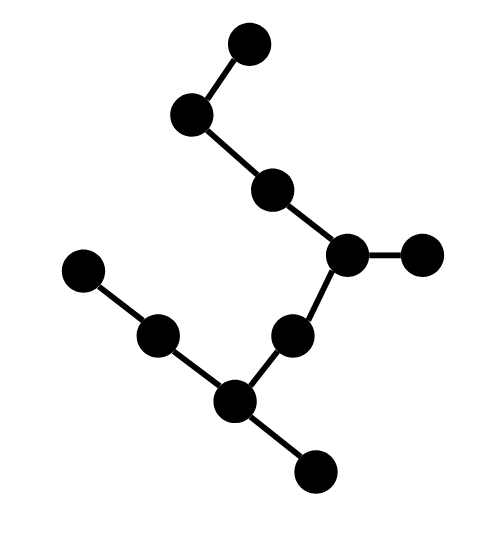A port of @Ajax1234's Python code in Scala.
1987 bytes, it can be golfed much more.
Golfed version. Attempt This Online!
def e(edges: List[(Int, Int)]): Set[Int] = {
edges.flatMap { case (a, b) => List(a, b) }.toSet
}
def t[A](seq: Seq[A]): List[A] = {
seq.toList
}
def b(edges: List[(Int, Int)]): Map[Int, Set[Int]] = {
edges.foldLeft(Map[Int, Set[Int]]()) { (A, edge) =>
val (a, b) = edge
A.updated(a, A.getOrElse(a, Set()) + b)
.updated(b, A.getOrElse(b, Set()) + a)
}
}
def f(A: Map[Int, Set[Int]]): Map[List[Int], List[List[Int]]] = {
var queue = A.filter(_._2.size == 1).keys.map(node => (node, List(node), List(A(node).size))).toList
var paths = Map[List[Int], List[List[Int]]]()
while (queue.nonEmpty) {
val (currentNode, path, degrees) = queue.head
queue = queue.tail
var isLeaf = true
for (neighbor <- A(currentNode) -- path.toSet) {
queue = queue :+ (neighbor, path :+ neighbor, degrees :+ A(neighbor).size)
isLeaf = false
}
if (isLeaf) {
val d= t(degrees)
val r= t(degrees.reverse)
if (paths.contains(d)) {
if (!paths(d).contains(path) && !paths(d).contains(path.reverse)) {
paths = paths.updated(d, paths(d) :+ path)
}
} else if (paths.contains(r)) {
if (!paths(r).contains(path) && !paths(r).contains(path.reverse)) {
paths = paths.updated(r, paths(r) :+ path)
}
} else {
paths = paths.updated(d, List(path))
}
}
}
paths
}
def c(edges: List[(Int, Int)]): Int = {
val paths = f(b(edges))
var u= 0
for ((degrees, pathList) <- paths) {
var subgraphs = List[List[List[Int]]]()
for (path<-pathList) {
val E=edges.filter { case (a, b) => !path.contains(a) && !path.contains(b) }
val N= e(edges).diff(e(E)).diff(path.toSet)
val newSubgraph = f(b(E ++ N.map(node => (node, node)))).keys.toList
subgraphs = subgraphs :+ newSubgraph.map(_.sorted)
}
u+= subgraphs.distinct.size
}
u
}
Ungolfed version. Attempt This Online!
import scala.math.Ordering.Implicits.seqOrdering
object Main {
def extractNodesFromEdges(edges: List[(Int, Int)]): Set[Int] = {
edges.flatMap { case (a, b) => List(a, b) }.toSet
}
def toTuple[A](seq: Seq[A]): List[A] = {
seq.toList
}
def buildAdjacencyList(edges: List[(Int, Int)]): Map[Int, Set[Int]] = {
edges.foldLeft(Map[Int, Set[Int]]()) { (adjacencyList, edge) =>
val (a, b) = edge
adjacencyList.updated(a, adjacencyList.getOrElse(a, Set()) + b)
.updated(b, adjacencyList.getOrElse(b, Set()) + a)
}
}
def findAllPaths(adjacencyList: Map[Int, Set[Int]]): Map[List[Int], List[List[Int]]] = {
var queue = adjacencyList.filter(_._2.size == 1).keys.map(node => (node, List(node), List(adjacencyList(node).size))).toList
var paths = Map[List[Int], List[List[Int]]]()
while (queue.nonEmpty) {
val (currentNode, path, degrees) = queue.head
queue = queue.tail
var isLeaf = true
for (neighbor <- adjacencyList(currentNode) -- path.toSet) {
queue = queue :+ (neighbor, path :+ neighbor, degrees :+ adjacencyList(neighbor).size)
isLeaf = false
}
if (isLeaf) {
val degreesTuple = toTuple(degrees)
val reversedDegreesTuple = toTuple(degrees.reverse)
if (paths.contains(degreesTuple)) {
if (!paths(degreesTuple).contains(path) && !paths(degreesTuple).contains(path.reverse)) {
paths = paths.updated(degreesTuple, paths(degreesTuple) :+ path)
}
} else if (paths.contains(reversedDegreesTuple)) {
if (!paths(reversedDegreesTuple).contains(path) && !paths(reversedDegreesTuple).contains(path.reverse)) {
paths = paths.updated(reversedDegreesTuple, paths(reversedDegreesTuple) :+ path)
}
} else {
paths = paths.updated(degreesTuple, List(path))
}
}
}
paths
}
def countUniqueSubgraphs(edges: List[(Int, Int)]): Int = {
val paths = findAllPaths(buildAdjacencyList(edges))
var uniqueCount = 0
for ((degrees, pathList) <- paths) {
var subgraphs = List[List[List[Int]]]()
for (path <- pathList) {
val remainingEdges = edges.filter { case (a, b) => !path.contains(a) && !path.contains(b) }
val remainingNodes = extractNodesFromEdges(edges).diff(extractNodesFromEdges(remainingEdges)).diff(path.toSet)
val newSubgraph = findAllPaths(buildAdjacencyList(remainingEdges ++ remainingNodes.map(node => (node, node)))).keys.toList
subgraphs = subgraphs :+ newSubgraph.map(_.sorted)
}
uniqueCount += subgraphs.distinct.size
}
uniqueCount
}
def main(args: Array[String]): Unit = {
println(countUniqueSubgraphs(List((1, 2), (2, 3), (3, 4), (3, 5))))
println(countUniqueSubgraphs(List((1, 2), (2, 3), (3, 4), (5, 6), (6, 7), (3, 7), (7, 8))))
println(countUniqueSubgraphs(List((1, 2), (2, 3), (3, 4), (3, 5), (3, 6), (3, 7))))
println(countUniqueSubgraphs(List((1, 2), (2, 3), (3, 4), (3, 5), (5, 6), (6, 7), (6, 8), (6, 9))))
println(countUniqueSubgraphs(List((1, 2), (2, 3), (3, 4), (4, 5), (4, 6), (7, 8), (8, 9), (6, 9), (9, 10))))
println(countUniqueSubgraphs(List((1, 2), (2, 3), (3, 4), (4, 5), (4, 6), (6, 7), (4, 8), (8, 9), (9, 10), (9, 11), (11, 12))))
println(countUniqueSubgraphs(List((1, 2), (2, 3), (2, 4), (4, 5), (4, 6), (6, 7), (7, 8), (7, 9))))
}
}











[[1, 2], [2, 3], [2, 4], [4, 5], [4, 6], [6, 7], [7, 8], [7, 9]]this has five backbones. This breaks solutions which try to check isomorphism of two paths by only comparing number of nodes connected to each node on the path. \$\endgroup\$